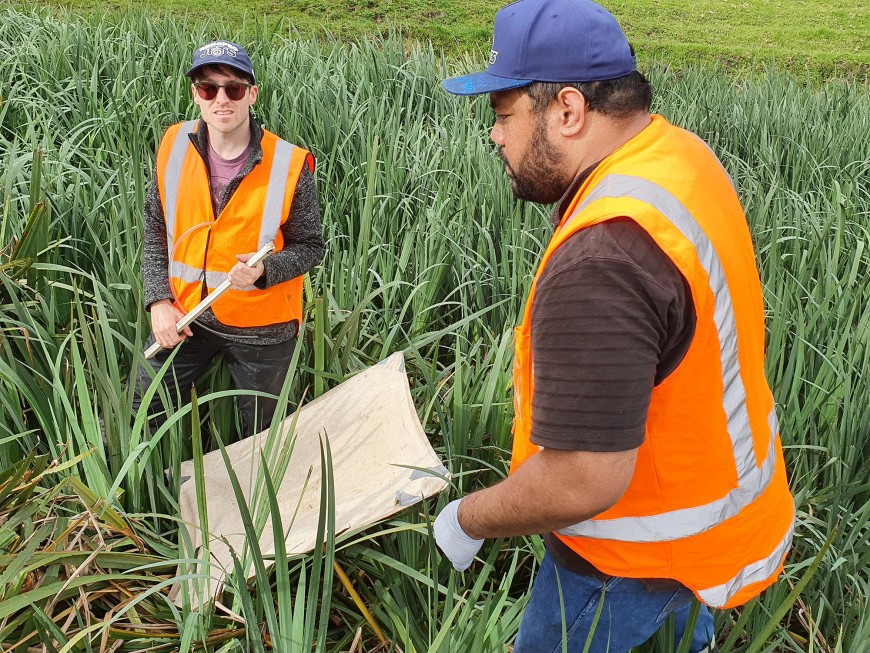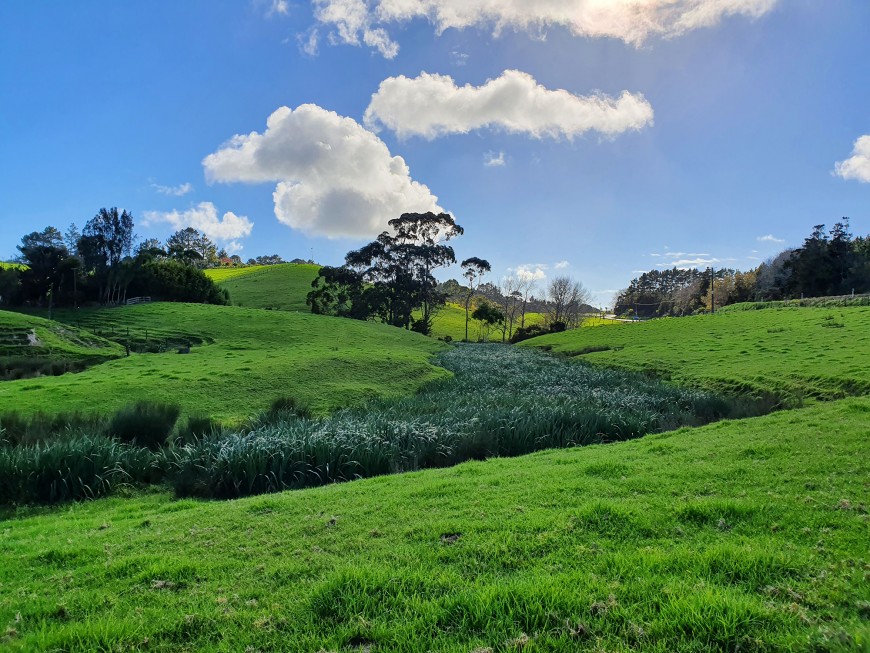Yellow Flag Iris Project Soldiers on
The CBC has led the way with host specificity testing of the iris flea beetle. So far 35 species and varieties in the Iridaceae family have been subjected to no-choice testing with the flea beetle. The preliminary results clearly demonstrated that the flea beetle is oligophagous (eating only a few closely related plant species), specialising on plant species in the Iris genus. Larvae of the flea beetle were not able to complete development on any plant species or varieties outside of this genus. In addition to yellow flag iris, flea beetle larvae developed on the following species: I. domestica, I. confusa, two varieties of I. laevigata, two varieties of I. spuria, I. foetidissima and I. orientalis. Four of these species (I. laevigata, I. spuria, I. foetidissima and I. orientalis) were important for host testing for New Zealand because all four are naturalised here: three are approved species, but I. foetidissima, or stinking iris, is regarded as a weed.

Zane McGrath and Temo Talie sampling yellow flag
In no-choice larval development tests, the flea beetle was able to complete a full life cycle on stinking iris. Further, adult emergence on stinking iris began a week earlier and ended a month earlier than emergence on yellow flag iris. However, the total number of adults that emerged from stinking iris was 38% of those that emerged from yellow flag iris. Despite being shorter in stature and having narrower leaves compared to yellow flag iris, stinking iris has similar below-ground organ structures that are crucial for development of the flea beetle larvae. However, further testing will need to be conducted to determine the preference and performance of the beetle on this non-target plant in comparison to yellow flag iris. This will assist in assessing the potential host range of the beetle in New Zealand, should it be released.
Another encouraging finding by the CBC is that the flea beetle has high fecundity under controlled conditions in the laboratory. During a 3-month study between April and July 2021, the number of captive flea beetles increased five-fold when reared on their host plant, yellow flag iris. This prolific increase in beetle numbers in one generation is good news for mass-rearing efforts, and a high reproductive capacity will increase the chances of establishment and control of yellow flag iris.
While significant progress with host testing the flea beetle has been made, there have also been a couple of setbacks. Seeds of two native Libertia species that were sent to the CBC for host testing failed to germinate. “Despite this, we have a couple of backup plans in place,” said Chris McGrannachan, who leads the project. “Our collaborators at the CBC still have plenty of Libertia seeds to sow, and I managed to locate a useful guide for propagating Libertia, which they are now using,” he added. Failing this, Chris and the CBC will look into acquiring permits to send root material of the Libertia species to South Africa, which should make growing the plants much easier. Once the Libertia species have been tested, all six species pertinent to host specificity testing of the beetle in a New Zealand context will have been tested.
Covid-19 has also caused delays in importing a second candidate biocontrol agent, the iris seed weevil (Mononychus punctumalbum), into containment at the CBC for host specificity testing. However, with pandemic travel restrictions easing around the world, plans to import the weevil are looking set to materialise later this year. Host specificity testing of this candidate agent can then begin once a thriving colony has been established there.
The CBC has also made headway in determining the DNA profiles of southern hemisphere yellow flag iris populations. Leaf material collected throughout the distribution range of yellow flag iris in New Zealand was sent to the CBC in late 2019 for molecular analysis. This analysis will help to determine the genetic diversity of New Zealand yellow flag iris populations (the species is capable of both sexual and vegetative reproduction), and their genetic diversity and relatedness in comparison to other southern hemisphere populations, as well as the native range populations.
Meanwhile, surveys in New Zealand have been completed to identify invertebrates and fungal pathogens associated with yellow flag iris, the results of which will be presented in a report to the National Biocontrol Collective. Surveys were completed in both the North and South Islands in May 2021 and January 2022. These surveys are important to identify any local organisms that might be attacking the weed, and to ensure that any candidate biocontrol agents are not already present. They also enable us to predict the risk of parasitism of any introduced biocontrol agents by determining the presence of ‘native analogues’. Native invertebrates that are closely related to a prospective biocontrol agent may have parasitoid natural enemies capable of transferring to the agent, reducing their effectiveness. Other species may be predatory, or antagonistic through disrupting feeding by a candidate biocontrol agent, so it is important to determine their presence.
Results of these surveys revealed a total of 81 invertebrate species or taxonomic units (where identification to species level was not feasible), of which 38 are herbivores. However, most species were only found rarely or occasionally, and any damage caused to the roots, leaves and stems of yellow flag iris was minimal. The most common herbivore recorded was the introduced meadow spittlebug (Philaenus spumarius), which feeds on a broad range of plants. The lack of feeding damage to yellow flag iris means there is unlikely to be intense competition for the iris flea beetle or the iris seed weevil in New Zealand. This, coupled with the fact that no beetle parasitoids were recorded during the surveys, suggests the impact of these two natural enemies could be high.

Yellow flag iris infestation at Mangawhai in the North Island
A total of 31 fungal pathogen species from 19 genera were found in association with New Zealand populations of yellow flag iris. The most common plant pathogens associated with yellow flag iris disease symptoms have a wide host range, and none had any major impact on the plants observed. One species (Rachicladosporium iridis) isolated from leaf spots on yellow flag iris has only been found on plants from the genus Iris. However, the fungus did not seem to have a significant impact on yellow flag iris and was found at only one location. The report concludes that no fungal pathogens or invertebrates recorded in New Zealand offer potential as biocontrol agents, and we should continue to pursue the iris flea beetle and the iris seed weevil as the most promising candidates for biocontrol of yellow flag iris.
Key contact

